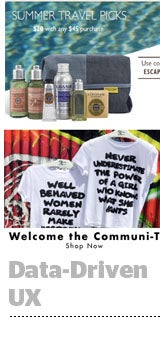Traditional web analytics tell advertisers if someone converted, but don’t always provide the context for why.
A new breed of analytics solutions, such as ContentSquare and Qubit, hope to break free of these confines by combining data and machine learning to improve personalization. And retailers are among their earliest adopters.
French beauty and skin care brand L’Occitane, for instance, wanted to leverage data to “offer a seamless UX to visitors and ultimately increase sales,” said Thalie Farinaud, the company’s VP of digital transformation and commerce.
That objective was difficult because L’Occitane had separate teams in ecommerce, design, customer acquisition and CRM using different analytics tools. And IT or ecommerce personnel typically chose the web analytics tools but didn’t consider the digital marketing or acquisition teams’ needs.
“If you are an acquisition manager, you don’t need to see what the CMO sees, and you don’t talk in the same language as the designer,” said Efrat Ravid, chief of marketing and strategy for ContentSquare. “We’re seeing [more interest] from acquisition managers to see the data and conversions that content produces.”
To achieve the results it wanted, L’Occitane had to centralize its global team around a single and more modern tool.
“We realized we needed to focus on UX in order to improve L’Occitane’s engagement and conversions, [but we also needed to] understand the visitor’s shopping behavior to inform the redesign of the site,” Farinaud added.
So L’Occitane deployed ContentSquare, which collects user actions, such as mouse movements, clicks or swipes in-app, through a piece of JavaScript code it embeds onsite, rather than through traditional tags.
The goal is to provide more context around user sessions in aggregate.
Heatmapping technology, which isn’t new, is only one part of ContentSquare’s offering. It also claims to improve L’Occitane’s ability to diagnose a UX challenge, such as the suboptimal placement of a video, and its potential effect on conversions.
L’Occitane also integrated UX analytics with A/B testing and campaign management.
ContentSquare’s machine-learning bot, Arti, automatically makes recommendations for fixing UX problems, such as replacing underperforming content with alternatives that are more likely to drive conversions.
“Arti provided customized [recommendations] based off the feedback we received from the customer and allows us to predict the impact of user decisions,” Farinaud said.
L’Occitane has seen a 2% lift in conversion rates by tweaking features on its site and app according to Arti’s recommendations.
Another retailer, upscale women’s apparel brand Alice + Olivia, uses ecommerce personalization platform Qubit to ramp up its personalization strategy.
One feature is a virtual fitting room, which it’s planning as much more than a shopping companion.
“We [will] allow you to create your own avatar, input your own information, add items to your fitting room, and then our machine learning suggests best products for the customer as they go,” said Marianna Satanas, VP of ecommerce for Alice + Olivia, at a Qubit ecommerce client event.
In the background, the brand will collect valuable data points about consumers’ sizes, style and color preferences, which helps inform its acquisition team.
“If they returned a product, we know that maybe it didn’t fit them,” Satanas said. “Those are insights we can also feed to our design team.”
To date, Alice + Olivia didn’t have a standard CRM system. Without the burden of old technology, the brand can be more flexible about creating personalized offers on the fly.
Alice + Olivia is starting to tailor product recommendations based on shoppers’ personas. For instance, if they abandoned their carts, the brand might recommend they “check these items out instead.”
But, if they are first-time visitors, the home page might show what’s “trending now.” Then, if any consumers return, they’ll get offers recommended “just for you.”
Automating offers using machine learning and personalization ultimately helps the brand better retain shoppers.
“Maybe [we’re providing] promotions for our most engaged segments [through flash sales] or sneak peeks at collections based on how loyal you are,” Satanas said. “We’re creating a tiered program supported by an omnichannel CRM.”













